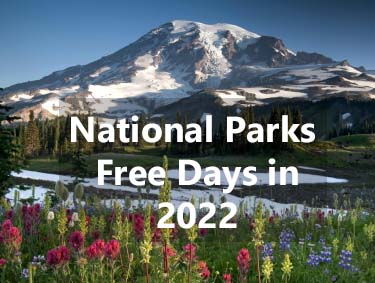
There are 5 FEE FREE days to visit our National Parks in 2022. Find all the National Parks in Washington State, plus, many more ways to get there free. (Keep reading below)
January 17 (Monday) in honor of Martin Luther King Jr. Day
April 16 (Saturday) First day of National Park Week
August 4 (Wednesday) Anniversary of the Great American Outdoors Act
September 24 (Saturday) National Public Lands Day
November 11 (Thursday) Veterans Day
See https://www.nps.gov/planyourvisit/fee-free-parks.htm for more information

Free Access for 4th Graders!
| 4th graders have free access to National Parks year-round through the EVERY KID OUTDOORS program. See their site for more information and to print your pass! https://www.everykidoutdoors.gov/index.htm |
There are several other discounted passes available and free passes for military service members.
| There are several other discounted passes available and free passes for military service members. See the full National Park Service for more information. https://www.nps.gov/planyourvisit/passes.htm |
National “Parks” in Washington State (3)+ 14 other sites :
- NATIONAL PARK “Mount Rainier” This park is accessible from Ashford, Enumclaw, Packwood and Wilkeson, WA. Ascending to 14,410 feet above sea level, Mount Rainier stands as an icon in the Washington landscape. An active volcano, Mount Rainier is the most glaciated peak in the contiguous U.S.A., spawning five major rivers. Subalpine wildflower meadows ring the icy volcano while ancient forest cloaks Mount Rainier’s lower slopes. Wildlife abounds in the park’s ecosystems. A lifetime of discovery awaits.
- NATIONAL PARK “North Cascades” in Marblemount, WA Less than three hours from Seattle, an alpine landscape beckons. Discover communities of life adapted to moisture in the west and recurring fire in the east. Explore jagged peaks crowned by more than 300 glaciers. Listen to cascading waters in forested valleys. Witness a landscape sensitive to the Earth’s changing climate. Help steward the ecological heart of the Cascades.
- NATIONAL PARK “Olympic” in Port Angeles, WA. With its incredible range of precipitation and elevation, diversity is the hallmark of Olympic National Park. Encompassing nearly a million acres, the park protects a vast wilderness, thousands of years of human history, and several distinctly different ecosystems, including glacier-capped mountains, old-growth temperate rain forests, and over 70 miles of wild coastline. Come explore!
- NATIONAL RECREATION AREA “Lake Roosevelt” You can find this hidden gem in Coulee Dam (Northeast Washington). The ancient geologic landscape of the upper Columbia River cradles Lake Roosevelt in walls of stone carved by massive ice age floods. Come explore the shorelines and learn the stories of American Indians, traders and trappers, settlers and dam builders who called this place home. Swim, boat, hike, camp, and fish in this beautiful area.
- NATIONAL HISTORICAL PARK “Klondike Gold Rush – Seattle Unit” in Seattle, WA. Seattle flourished during and after the Klondike Gold Rush. Merchants supplied people from around the world passing through this port city on their way to a remarkable adventure in Alaska. Today, the park is your gateway to learn about the Klondike Gold Rush, explore the area’s public lands, and engage with the local community.
- NATIONAL HISTORICAL PARK “Lewis and Clark” Long Beach, WA to Cannon Beach, OR. The park encompasses sites along the Columbia River and the Pacific Coast. Follow in the footsteps of the explorers and have an adventure in history. Explore the timeless rainforests and majestic coastal vistas. Discover the rich heritage of the native people. Unfold the dramatic stories of America’s most famous explorers.
- NATIONAL HISTORICAL PARK “Manhattan Project” Manhattan Project National Historical Park in Hanford, WA, NM and TN. This site tells the story about the people, events, science, and engineering that led to the creation of the atomic bomb, which helped end World War II.
- NATIONAL HISTORICAL PARK “San Juan Island” in Friday Harbor, WA. San Juan Island is well known for splendid vistas, saltwater shore, quiet woodlands, orca whales and one of the last remaining native prairies in the Puget Sound/Northern Straits region. But it was also here in 1859 that the United States and Great Britain nearly went to war over possession of the island, the crisis ignited by the death of a pig.
- NATIONAL HISTORICAL RESERVE “Ebey’s Landing” in Coupeville, WA. This stunning landscape at the gateway to Puget Sound, with its rich farmland and promising seaport, lured the earliest American pioneers north of the Columbia River to Ebey’s Landing. Today Ebey’s Landing National Historical Reserve preserves the historical, agricultural and cultural traditions of both Native and Euro-American – while offering spectacular opportunities for recreation.
- NATIONAL HISTORIC SITE “Fort Vancouver” in Vancouver, OR, WA. Located on the north bank of the Columbia River, in sight of snowy mountain peaks and a vibrant urban landscape, this park has a rich cultural past. From a frontier fur trading post, to a powerful military legacy, the magic of flight, and the origin of the American Pacific Northwest, history is shared at four unique sites. Discover stories of transition, settlement, conflict, and community.
- NATIONAL HISTORIC SITE “Minidoka” in Jerome, ID, and WA The Pearl Harbor attack intensified existing hostility towards Japanese Americans. As wartime hysteria mounted, President Roosevelt signed Executive Order 9066 forcing over 120,000 West Coast persons of Japanese ancestry (Nikkei) to leave their homes, jobs, and lives behind, forcing them into one of ten prison camps spread across the nation because of their ethnicity. This is Minidoka’s story.
- NATIONAL HISTORIC SITE ‘Whitman Mission” in Walla Walla, WA The 1847 attack on the Whitmans horrified Americans and impacted the lives of the peoples of the Columbia Plateau for decades afterwards. Was killing the Whitmans justified legal retribution, an act of revenge, or some combination of both? The circumstances that surround this tragic event resonate with modern issues of cultural interaction and differing perspectives.
- NATIONAL GEOLOGIC TRAIL “Ice Age Floods” in WA, OR, ID, and MT. At the end of the last Ice Age, some 12,000 to 17,000 years ago, a series of cataclysmic floods occurred in what is now the northwest region of the United States, leaving a lasting mark of dramatic and distinguishing features on the landscape of parts of the States of Montana, Idaho, Washington and Oregon.” Public Law 111-11, March 30, 2009
- NATIONAL HISTORIC TRAIL “Lewis & Clark” in Sixteen States: IA, ID, IL, IN, KS, KY, MO, MT, NE, ND, OH, OR, PA, SD, WA, and WV The Lewis and Clark National Historic Trail is approximately 4,900 miles long, extending from Pittsburgh, Pennsylvania, to the mouth of the Columbia River, near present day Astoria, Oregon. It follows the historic outbound and inbound routes of the Lewis and Clark Expedition as well as the preparatory section from Pittsburgh, Pennsylvania to Wood River, Illinois.
- NATIONAL HISTORIC TRAIL “Oregon” in Various States: ID, KS, MO, NE, OR, WA, and WY. Imagine yourself an emigrant headed for Oregon: would promises of lush farmlands and a new beginning lure you to leave home and walk for weeks? More than 2,000 miles of trail ruts and traces can still be seen along the Oregon National Historic Trail in six states and serve as reminders of the sacrifices, struggles, and triumphs of early American settlers.
- AFFILIATED AREA “Wing Luke Museum” in Seattle, WA. More than a museum, the Wing is an experience. A chance to truly understand what it was – and is – to be Asian American in the Pacific Northwest. Take a guided tour of a historic hotel and learn the inside story about what makes the local Chinatown-International District unique. Visitors explore thought-provoking exhibitions of real stories, including actor and martial arts master Bruce Lee.

Visit https://www.nps.gov/state/wa/index.htm for more info and to find a park near you.
















